Impact of Pandemic on Fashion Industry: Business Environment Analysis
VerifiedAdded on 2022/12/23
|10
|2609
|47
Report
AI Summary
This report examines the global business environment's impact on the fashion industry, focusing on the effects of the pandemic. It employs PESTEL and Porter's Five Forces analyses to assess external factors, including political, economic, social, technological, environmental, and legal aspects. The report also uses SWOT analysis to identify the industry's strengths, weaknesses, opportunities, and threats. Key challenges include sustainability concerns, consumer shifts, and the need for digitalization. The report highlights how businesses adapted to the changing environment through technological advancements and employee training, providing a comprehensive overview of the industry's current state and future prospects.
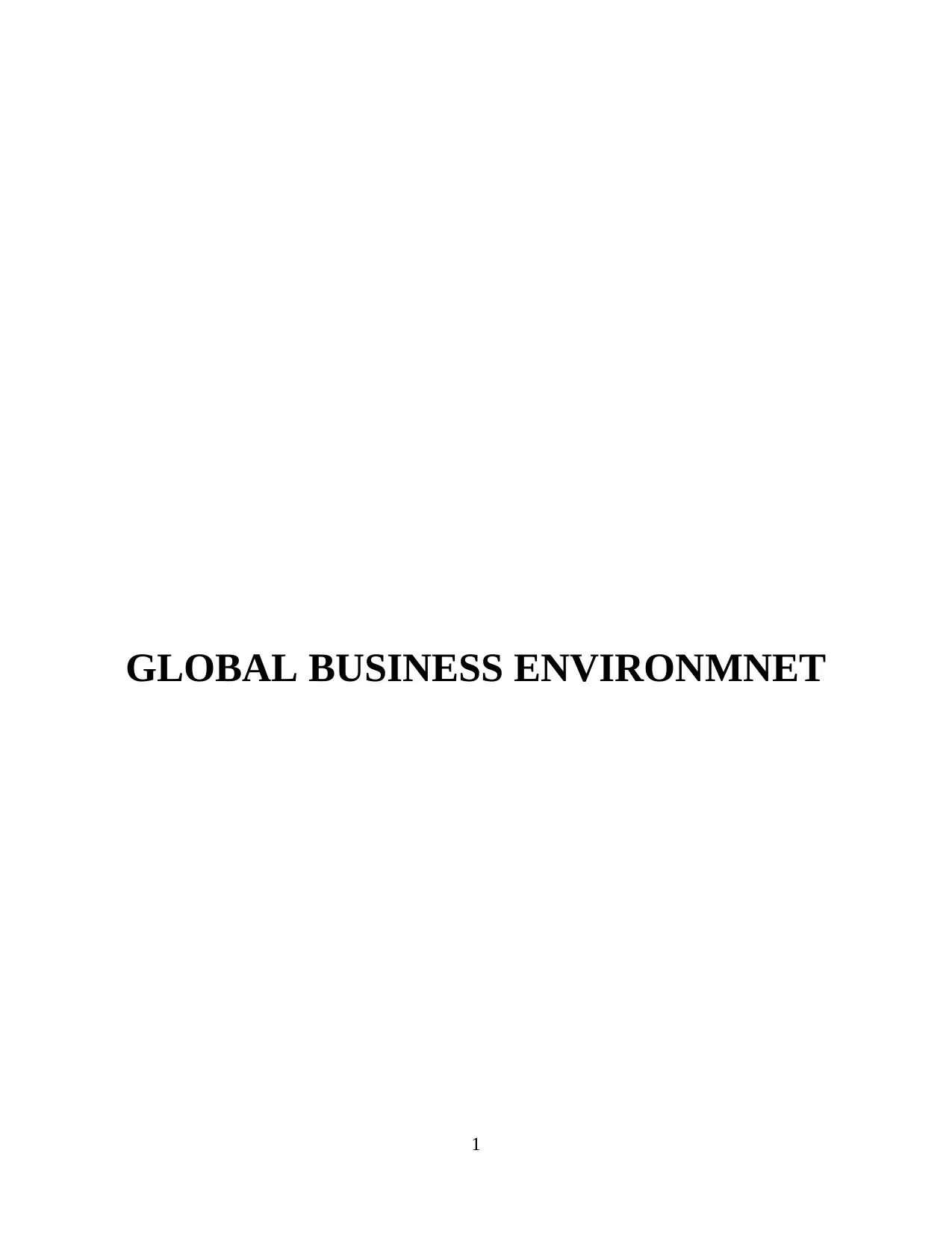
GLOBAL BUSINESS ENVIRONMNET
1
1
Paraphrase This Document
Need a fresh take? Get an instant paraphrase of this document with our AI Paraphraser
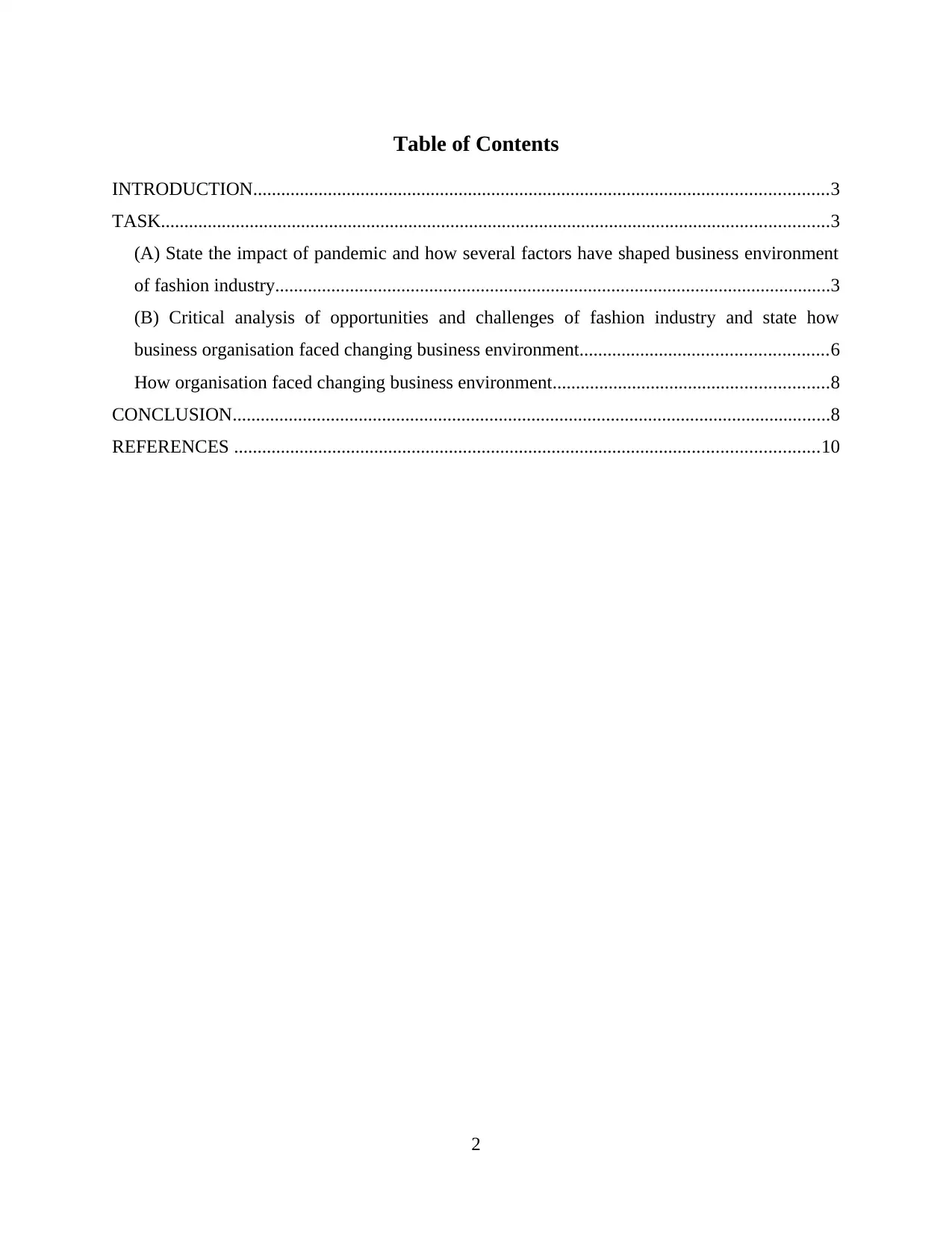
Table of Contents
INTRODUCTION...........................................................................................................................3
TASK...............................................................................................................................................3
(A) State the impact of pandemic and how several factors have shaped business environment
of fashion industry.......................................................................................................................3
(B) Critical analysis of opportunities and challenges of fashion industry and state how
business organisation faced changing business environment.....................................................6
How organisation faced changing business environment...........................................................8
CONCLUSION................................................................................................................................8
REFERENCES .............................................................................................................................10
2
INTRODUCTION...........................................................................................................................3
TASK...............................................................................................................................................3
(A) State the impact of pandemic and how several factors have shaped business environment
of fashion industry.......................................................................................................................3
(B) Critical analysis of opportunities and challenges of fashion industry and state how
business organisation faced changing business environment.....................................................6
How organisation faced changing business environment...........................................................8
CONCLUSION................................................................................................................................8
REFERENCES .............................................................................................................................10
2

INTRODUCTION
Global business environment is environment in different sovereign country. The global
business environment can be classified under two categories, such as external and internal
environment. For operating a business on international level, a company must analyse their
social factors and other factors which are responsible for change in the operations of
management (Abdullah and Mansor, 2018). The main four components of global business
environment can be categorised as geographic, socio-cultural, economic, legal and political
factors. The aim of the project report is to analyse the factors which are responsible to create an
impact on the organisation during and post pandemic. This report also highlights the important
factors which states how these factors are responsible for the change in business environment
and monitor the aspects which created opportunities for business growth and several challenges
which are faced by fashion industry due to the global pandemic.
TASK
(A) State the impact of pandemic and how several factors have shaped business environment of
fashion industry
The global pandemic have created a huge impact on the sale, profits and operations of
fashion industry, the impact on the business environment can be analysed with the help of Pestle
analysis and Porter five forces.
Porter Five Forces
The porter five forces model is a technique through which a business can analyse the
competitiveness of the target market and through monitoring such factors, a business can
maximise their profits. The five forces which are analysed with the help of porter fie force
approach are:
Suppliers potential- The suppliers hold less power or potential in the fashion industry.
The potential of suppliers increase the cost of products and services which are
manufactured by the organisation (Akhtar and Sushil, 2018). In the fashion industry,
suppliers hold less power as the company directly source their products with the help of
third manufactures who gain maximum profits from such operations. Due to the global
pandemic, fashion industry have faced big challenges which have created an negative
impact on the functioning of such business entities. As the potential of suppliers is low in
3
Global business environment is environment in different sovereign country. The global
business environment can be classified under two categories, such as external and internal
environment. For operating a business on international level, a company must analyse their
social factors and other factors which are responsible for change in the operations of
management (Abdullah and Mansor, 2018). The main four components of global business
environment can be categorised as geographic, socio-cultural, economic, legal and political
factors. The aim of the project report is to analyse the factors which are responsible to create an
impact on the organisation during and post pandemic. This report also highlights the important
factors which states how these factors are responsible for the change in business environment
and monitor the aspects which created opportunities for business growth and several challenges
which are faced by fashion industry due to the global pandemic.
TASK
(A) State the impact of pandemic and how several factors have shaped business environment of
fashion industry
The global pandemic have created a huge impact on the sale, profits and operations of
fashion industry, the impact on the business environment can be analysed with the help of Pestle
analysis and Porter five forces.
Porter Five Forces
The porter five forces model is a technique through which a business can analyse the
competitiveness of the target market and through monitoring such factors, a business can
maximise their profits. The five forces which are analysed with the help of porter fie force
approach are:
Suppliers potential- The suppliers hold less power or potential in the fashion industry.
The potential of suppliers increase the cost of products and services which are
manufactured by the organisation (Akhtar and Sushil, 2018). In the fashion industry,
suppliers hold less power as the company directly source their products with the help of
third manufactures who gain maximum profits from such operations. Due to the global
pandemic, fashion industry have faced big challenges which have created an negative
impact on the functioning of such business entities. As the potential of suppliers is low in
3
⊘ This is a preview!⊘
Do you want full access?
Subscribe today to unlock all pages.

Trusted by 1+ million students worldwide

the industry, after the global pandemic the situation ca be analysed as more worse and
company aims to
Buyers potential- The potential of consumers results in decline in the prices of products
and services they purchase from the distributor. The most important factor which is
analysed using this approach is the bargaining ability and in fashion industry, the
bargaining ability of buyers is quite high. As there are many stores which can provide the
same quality of products, this creates a barrier for the company to attract and retain
potential buyers (Ali and Garg, 2017). As it can be observed that due to the global
pandemic fashion industry have faced huge loss in their sales which have affected the
profitability of business and their share in marketplace.
Competitive rivalry- This factor can create a huge impact on the operations of the
management and it can help affect the sale, profit and sustainability of the organisation
due to the changing market patterns and trends. The fashion industry involves high
competition as there are many retailers who sell similar products at different prices,
which is a responsible factor for increase in the competition of business. As due to
rapidly changing trends and patters, the market becomes saturated with similar products
very easily. Due to the global pandemic, the competition in the fashion industry turned
low as the industry have faced many challenges and the existing business are facing huge
loss.
Threat of new entrants- This factor focus on the new entrants and new business in the
marketplace who can give a huge competition to the existing companies. As there are
very less innovative ideas which are introduced in the fashion industry, this creates a
challenge for the exiting companies as new entrants can find the unique and innovative
approaches through which they can attract maximum customers. The fashion industry
involves high risk and reward for new entrants which can be dependent on the changing
market conditions and trends. Due to the global pandemic, the fashion industry have
faced many setbacks and there are low rate of entrants who aim to get involve in the
fashion industry (Cherunilam, 2020).
Threat of substitution- The factor focus on the threat of substitution of products and
services which are offered by the company. The threat of substitution in the fashion
industry is low as the industry holds high competition. All threats of substitution in the
4
company aims to
Buyers potential- The potential of consumers results in decline in the prices of products
and services they purchase from the distributor. The most important factor which is
analysed using this approach is the bargaining ability and in fashion industry, the
bargaining ability of buyers is quite high. As there are many stores which can provide the
same quality of products, this creates a barrier for the company to attract and retain
potential buyers (Ali and Garg, 2017). As it can be observed that due to the global
pandemic fashion industry have faced huge loss in their sales which have affected the
profitability of business and their share in marketplace.
Competitive rivalry- This factor can create a huge impact on the operations of the
management and it can help affect the sale, profit and sustainability of the organisation
due to the changing market patterns and trends. The fashion industry involves high
competition as there are many retailers who sell similar products at different prices,
which is a responsible factor for increase in the competition of business. As due to
rapidly changing trends and patters, the market becomes saturated with similar products
very easily. Due to the global pandemic, the competition in the fashion industry turned
low as the industry have faced many challenges and the existing business are facing huge
loss.
Threat of new entrants- This factor focus on the new entrants and new business in the
marketplace who can give a huge competition to the existing companies. As there are
very less innovative ideas which are introduced in the fashion industry, this creates a
challenge for the exiting companies as new entrants can find the unique and innovative
approaches through which they can attract maximum customers. The fashion industry
involves high risk and reward for new entrants which can be dependent on the changing
market conditions and trends. Due to the global pandemic, the fashion industry have
faced many setbacks and there are low rate of entrants who aim to get involve in the
fashion industry (Cherunilam, 2020).
Threat of substitution- The factor focus on the threat of substitution of products and
services which are offered by the company. The threat of substitution in the fashion
industry is low as the industry holds high competition. All threats of substitution in the
4
Paraphrase This Document
Need a fresh take? Get an instant paraphrase of this document with our AI Paraphraser
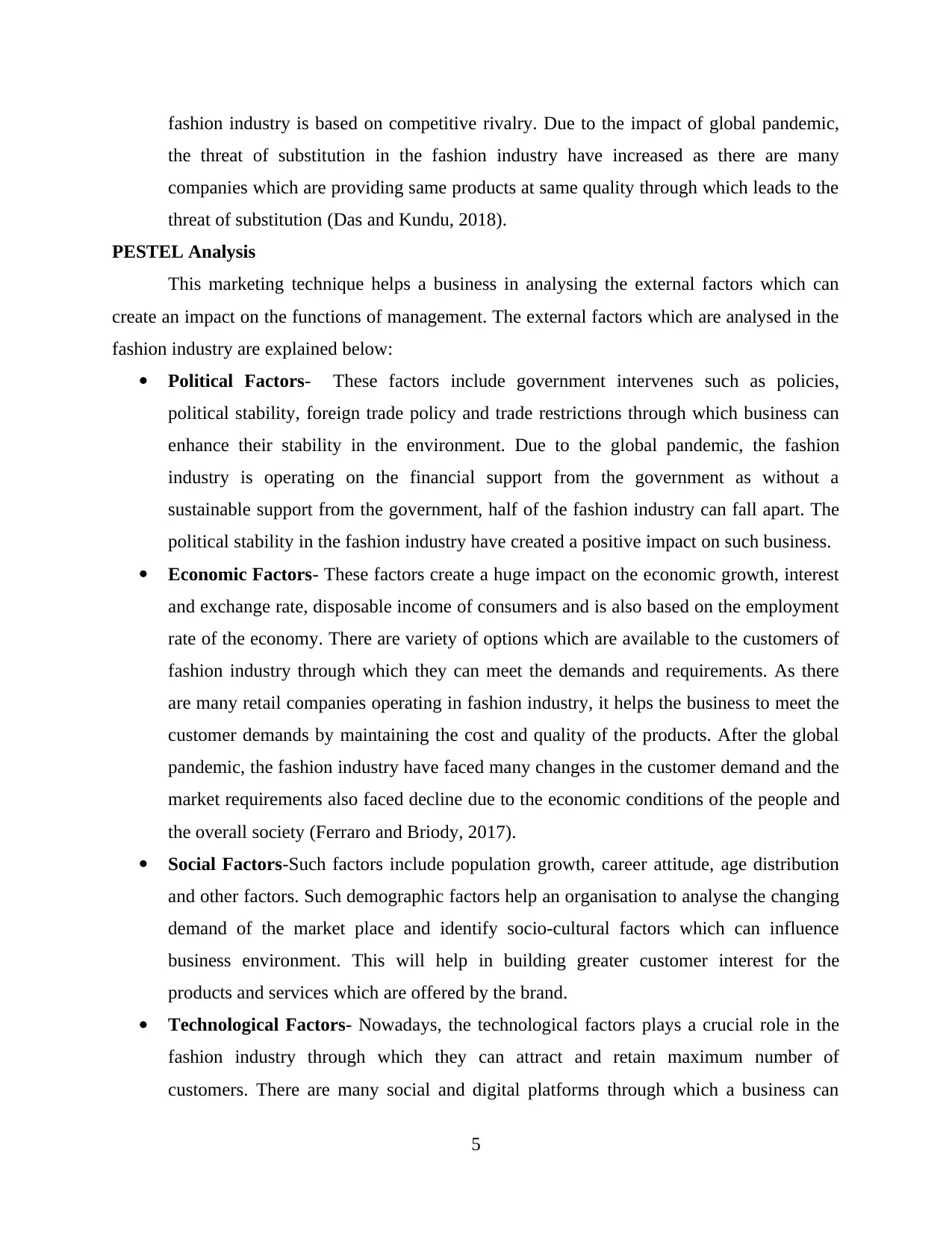
fashion industry is based on competitive rivalry. Due to the impact of global pandemic,
the threat of substitution in the fashion industry have increased as there are many
companies which are providing same products at same quality through which leads to the
threat of substitution (Das and Kundu, 2018).
PESTEL Analysis
This marketing technique helps a business in analysing the external factors which can
create an impact on the functions of management. The external factors which are analysed in the
fashion industry are explained below:
Political Factors- These factors include government intervenes such as policies,
political stability, foreign trade policy and trade restrictions through which business can
enhance their stability in the environment. Due to the global pandemic, the fashion
industry is operating on the financial support from the government as without a
sustainable support from the government, half of the fashion industry can fall apart. The
political stability in the fashion industry have created a positive impact on such business.
Economic Factors- These factors create a huge impact on the economic growth, interest
and exchange rate, disposable income of consumers and is also based on the employment
rate of the economy. There are variety of options which are available to the customers of
fashion industry through which they can meet the demands and requirements. As there
are many retail companies operating in fashion industry, it helps the business to meet the
customer demands by maintaining the cost and quality of the products. After the global
pandemic, the fashion industry have faced many changes in the customer demand and the
market requirements also faced decline due to the economic conditions of the people and
the overall society (Ferraro and Briody, 2017).
Social Factors-Such factors include population growth, career attitude, age distribution
and other factors. Such demographic factors help an organisation to analyse the changing
demand of the market place and identify socio-cultural factors which can influence
business environment. This will help in building greater customer interest for the
products and services which are offered by the brand.
Technological Factors- Nowadays, the technological factors plays a crucial role in the
fashion industry through which they can attract and retain maximum number of
customers. There are many social and digital platforms through which a business can
5
the threat of substitution in the fashion industry have increased as there are many
companies which are providing same products at same quality through which leads to the
threat of substitution (Das and Kundu, 2018).
PESTEL Analysis
This marketing technique helps a business in analysing the external factors which can
create an impact on the functions of management. The external factors which are analysed in the
fashion industry are explained below:
Political Factors- These factors include government intervenes such as policies,
political stability, foreign trade policy and trade restrictions through which business can
enhance their stability in the environment. Due to the global pandemic, the fashion
industry is operating on the financial support from the government as without a
sustainable support from the government, half of the fashion industry can fall apart. The
political stability in the fashion industry have created a positive impact on such business.
Economic Factors- These factors create a huge impact on the economic growth, interest
and exchange rate, disposable income of consumers and is also based on the employment
rate of the economy. There are variety of options which are available to the customers of
fashion industry through which they can meet the demands and requirements. As there
are many retail companies operating in fashion industry, it helps the business to meet the
customer demands by maintaining the cost and quality of the products. After the global
pandemic, the fashion industry have faced many changes in the customer demand and the
market requirements also faced decline due to the economic conditions of the people and
the overall society (Ferraro and Briody, 2017).
Social Factors-Such factors include population growth, career attitude, age distribution
and other factors. Such demographic factors help an organisation to analyse the changing
demand of the market place and identify socio-cultural factors which can influence
business environment. This will help in building greater customer interest for the
products and services which are offered by the brand.
Technological Factors- Nowadays, the technological factors plays a crucial role in the
fashion industry through which they can attract and retain maximum number of
customers. There are many social and digital platforms through which a business can
5
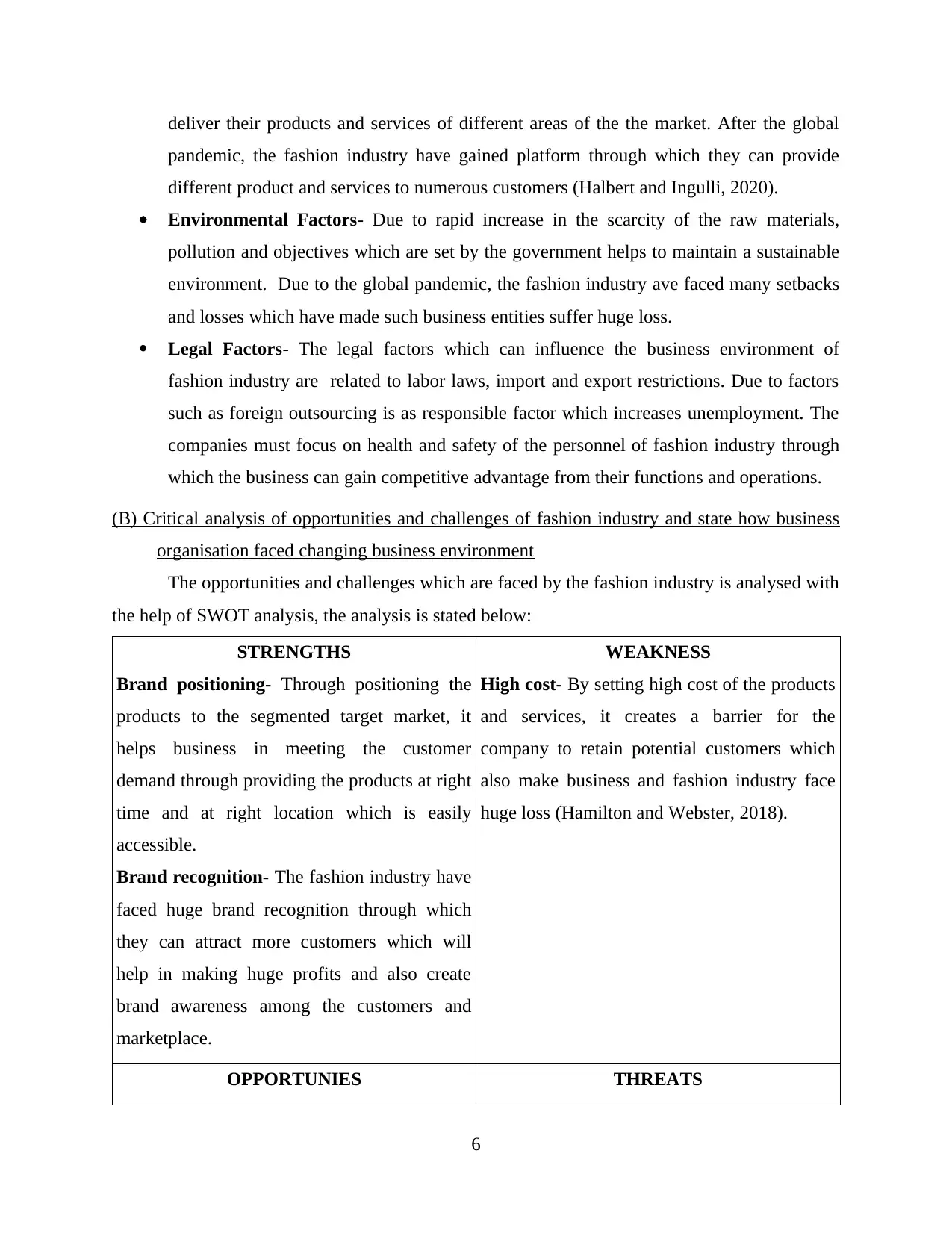
deliver their products and services of different areas of the the market. After the global
pandemic, the fashion industry have gained platform through which they can provide
different product and services to numerous customers (Halbert and Ingulli, 2020).
Environmental Factors- Due to rapid increase in the scarcity of the raw materials,
pollution and objectives which are set by the government helps to maintain a sustainable
environment. Due to the global pandemic, the fashion industry ave faced many setbacks
and losses which have made such business entities suffer huge loss.
Legal Factors- The legal factors which can influence the business environment of
fashion industry are related to labor laws, import and export restrictions. Due to factors
such as foreign outsourcing is as responsible factor which increases unemployment. The
companies must focus on health and safety of the personnel of fashion industry through
which the business can gain competitive advantage from their functions and operations.
(B) Critical analysis of opportunities and challenges of fashion industry and state how business
organisation faced changing business environment
The opportunities and challenges which are faced by the fashion industry is analysed with
the help of SWOT analysis, the analysis is stated below:
STRENGTHS
Brand positioning- Through positioning the
products to the segmented target market, it
helps business in meeting the customer
demand through providing the products at right
time and at right location which is easily
accessible.
Brand recognition- The fashion industry have
faced huge brand recognition through which
they can attract more customers which will
help in making huge profits and also create
brand awareness among the customers and
marketplace.
WEAKNESS
High cost- By setting high cost of the products
and services, it creates a barrier for the
company to retain potential customers which
also make business and fashion industry face
huge loss (Hamilton and Webster, 2018).
OPPORTUNIES THREATS
6
pandemic, the fashion industry have gained platform through which they can provide
different product and services to numerous customers (Halbert and Ingulli, 2020).
Environmental Factors- Due to rapid increase in the scarcity of the raw materials,
pollution and objectives which are set by the government helps to maintain a sustainable
environment. Due to the global pandemic, the fashion industry ave faced many setbacks
and losses which have made such business entities suffer huge loss.
Legal Factors- The legal factors which can influence the business environment of
fashion industry are related to labor laws, import and export restrictions. Due to factors
such as foreign outsourcing is as responsible factor which increases unemployment. The
companies must focus on health and safety of the personnel of fashion industry through
which the business can gain competitive advantage from their functions and operations.
(B) Critical analysis of opportunities and challenges of fashion industry and state how business
organisation faced changing business environment
The opportunities and challenges which are faced by the fashion industry is analysed with
the help of SWOT analysis, the analysis is stated below:
STRENGTHS
Brand positioning- Through positioning the
products to the segmented target market, it
helps business in meeting the customer
demand through providing the products at right
time and at right location which is easily
accessible.
Brand recognition- The fashion industry have
faced huge brand recognition through which
they can attract more customers which will
help in making huge profits and also create
brand awareness among the customers and
marketplace.
WEAKNESS
High cost- By setting high cost of the products
and services, it creates a barrier for the
company to retain potential customers which
also make business and fashion industry face
huge loss (Hamilton and Webster, 2018).
OPPORTUNIES THREATS
6
⊘ This is a preview!⊘
Do you want full access?
Subscribe today to unlock all pages.

Trusted by 1+ million students worldwide

Potential customer base- The fashion industry
have a strong customer base through which the
industry gain competitive advantage. This is
the opportunity of the
Competitive source of raw material-
Through sourcing raw materials and effective
utilisation of raw material help an organisation
in attracting numerous customers through
which they can make heir business profitable
(Luiz, Ganson and Wennmann, 2019).
Brand image- The fashion industry can
provide sustainable and ozone friendly
products which will help in meeting the
customer demands and thus it will crate an
opportunity for the fashion industry to attract
potential customers through which the overall
industry can gain competitive advantage.
Sustainability- One of the biggest challenge
which is faced by fashion industry is a
movement towards sustainability. As it can be
observed that fashion industry is one of the
biggest pollutant industry and it is also
involved in high wastage and pollution that is
done by such industries. Due to the global
pandemic, the consumers are more interested
in buying products which are sustainable
through which they can ensure the safety and
ensure the products which they use are cruelty
free and cause no harm to any animal or
environment.
Consumer shift- Due to rapid change in the
fashion industry,it is difficult for the
manufactures to stay updated with the latest
and new trends, customers and demand of the
marketplace. It is a challenge for the fashion
industry as consumers nowadays demands
transparency and sustainability in products
which are offered y the company. According to
the changing business environment and due to
the global pandemic, COVID-19, fashion
industry have faced huge shift in the demand
of the consumers and their buying potential.
Digitalization- Due to poor technological
strategies and lack in implementation of such
strategies, it is one of the responsible factors of
downfall in the fashion industry. With the help
of technology, the industry can meet the
demands and requirements of the marketplace.
7
have a strong customer base through which the
industry gain competitive advantage. This is
the opportunity of the
Competitive source of raw material-
Through sourcing raw materials and effective
utilisation of raw material help an organisation
in attracting numerous customers through
which they can make heir business profitable
(Luiz, Ganson and Wennmann, 2019).
Brand image- The fashion industry can
provide sustainable and ozone friendly
products which will help in meeting the
customer demands and thus it will crate an
opportunity for the fashion industry to attract
potential customers through which the overall
industry can gain competitive advantage.
Sustainability- One of the biggest challenge
which is faced by fashion industry is a
movement towards sustainability. As it can be
observed that fashion industry is one of the
biggest pollutant industry and it is also
involved in high wastage and pollution that is
done by such industries. Due to the global
pandemic, the consumers are more interested
in buying products which are sustainable
through which they can ensure the safety and
ensure the products which they use are cruelty
free and cause no harm to any animal or
environment.
Consumer shift- Due to rapid change in the
fashion industry,it is difficult for the
manufactures to stay updated with the latest
and new trends, customers and demand of the
marketplace. It is a challenge for the fashion
industry as consumers nowadays demands
transparency and sustainability in products
which are offered y the company. According to
the changing business environment and due to
the global pandemic, COVID-19, fashion
industry have faced huge shift in the demand
of the consumers and their buying potential.
Digitalization- Due to poor technological
strategies and lack in implementation of such
strategies, it is one of the responsible factors of
downfall in the fashion industry. With the help
of technology, the industry can meet the
demands and requirements of the marketplace.
7
Paraphrase This Document
Need a fresh take? Get an instant paraphrase of this document with our AI Paraphraser
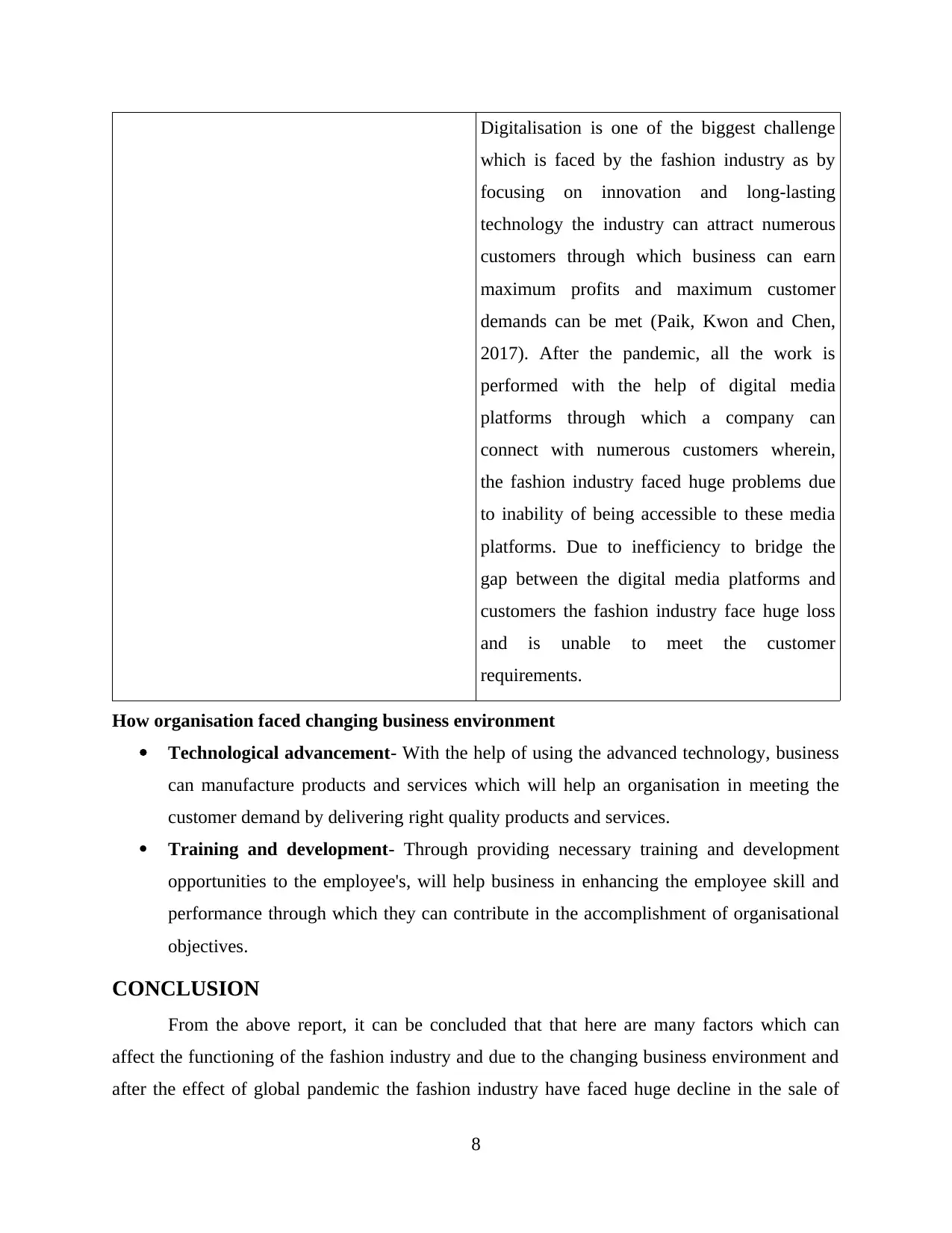
Digitalisation is one of the biggest challenge
which is faced by the fashion industry as by
focusing on innovation and long-lasting
technology the industry can attract numerous
customers through which business can earn
maximum profits and maximum customer
demands can be met (Paik, Kwon and Chen,
2017). After the pandemic, all the work is
performed with the help of digital media
platforms through which a company can
connect with numerous customers wherein,
the fashion industry faced huge problems due
to inability of being accessible to these media
platforms. Due to inefficiency to bridge the
gap between the digital media platforms and
customers the fashion industry face huge loss
and is unable to meet the customer
requirements.
How organisation faced changing business environment
Technological advancement- With the help of using the advanced technology, business
can manufacture products and services which will help an organisation in meeting the
customer demand by delivering right quality products and services.
Training and development- Through providing necessary training and development
opportunities to the employee's, will help business in enhancing the employee skill and
performance through which they can contribute in the accomplishment of organisational
objectives.
CONCLUSION
From the above report, it can be concluded that that here are many factors which can
affect the functioning of the fashion industry and due to the changing business environment and
after the effect of global pandemic the fashion industry have faced huge decline in the sale of
8
which is faced by the fashion industry as by
focusing on innovation and long-lasting
technology the industry can attract numerous
customers through which business can earn
maximum profits and maximum customer
demands can be met (Paik, Kwon and Chen,
2017). After the pandemic, all the work is
performed with the help of digital media
platforms through which a company can
connect with numerous customers wherein,
the fashion industry faced huge problems due
to inability of being accessible to these media
platforms. Due to inefficiency to bridge the
gap between the digital media platforms and
customers the fashion industry face huge loss
and is unable to meet the customer
requirements.
How organisation faced changing business environment
Technological advancement- With the help of using the advanced technology, business
can manufacture products and services which will help an organisation in meeting the
customer demand by delivering right quality products and services.
Training and development- Through providing necessary training and development
opportunities to the employee's, will help business in enhancing the employee skill and
performance through which they can contribute in the accomplishment of organisational
objectives.
CONCLUSION
From the above report, it can be concluded that that here are many factors which can
affect the functioning of the fashion industry and due to the changing business environment and
after the effect of global pandemic the fashion industry have faced huge decline in the sale of
8

their products which resulted into facing huge loss in their functions of the management. The
above report also highlights how buyers and suppliers play a crucial role in the sale of the
products and service offered by the company and this also highlights the competition in the
industry. It can be observed that the global pandemic, COVID-19 have affected the demand and
supply chain management of the fashion industry and such business entities have faced huge
loss.
9
above report also highlights how buyers and suppliers play a crucial role in the sale of the
products and service offered by the company and this also highlights the competition in the
industry. It can be observed that the global pandemic, COVID-19 have affected the demand and
supply chain management of the fashion industry and such business entities have faced huge
loss.
9
⊘ This is a preview!⊘
Do you want full access?
Subscribe today to unlock all pages.

Trusted by 1+ million students worldwide

REFERENCES
Books and journals
Abdullah, Y. A. and Mansor, M. N. B., 2018. The moderating effect of business environment on
the relationship between entrepreneurial skills and small business performance in Iraq.
International Journal of Entrepreneurship. 22(4). pp.1-11.
Akhtar, M. and Sushil, S., 2018. Strategic performance management system in uncertain
business environment. Business Process Management Journal.
Ali, I. and Garg, R. K., 2017. Marketing of services: Challenges & opportunities in context of the
globalization of business. International Journal of Engineering and Management
Research (IJEMR). 7(3). pp.522-526.
Cherunilam, F., 2020. International business. PHI Learning Pvt. Ltd..
Das, S. and Kundu, A., 2018. Individual and business environment: How effective interaction
affects sme development. International Journal of Engineering and Management
Research (IJEMR). 8(4). pp.101-113.
Ferraro, G. P. and Briody, E. K., 2017. The cultural dimension of global business. Taylor &
Francis.
Halbert, T. and Ingulli, E., 2020. Law and ethics in the business environment. Cengage Learning.
Hamilton, L. and Webster, P., 2018. The international business environment. Oxford University
Press.
Luiz, J.M., Ganson, B. and Wennmann, A., 2019. Business environment reforms in fragile and
conflict-affected states: From a transactions towards a systems approach. Journal of
International Business Policy. 2(3). pp.217-236.
Paik, Y., Kwon, J.W. and Chen, D., 2017. Global business: Connecting theory to reality. Taylor
& Francis.
10
Books and journals
Abdullah, Y. A. and Mansor, M. N. B., 2018. The moderating effect of business environment on
the relationship between entrepreneurial skills and small business performance in Iraq.
International Journal of Entrepreneurship. 22(4). pp.1-11.
Akhtar, M. and Sushil, S., 2018. Strategic performance management system in uncertain
business environment. Business Process Management Journal.
Ali, I. and Garg, R. K., 2017. Marketing of services: Challenges & opportunities in context of the
globalization of business. International Journal of Engineering and Management
Research (IJEMR). 7(3). pp.522-526.
Cherunilam, F., 2020. International business. PHI Learning Pvt. Ltd..
Das, S. and Kundu, A., 2018. Individual and business environment: How effective interaction
affects sme development. International Journal of Engineering and Management
Research (IJEMR). 8(4). pp.101-113.
Ferraro, G. P. and Briody, E. K., 2017. The cultural dimension of global business. Taylor &
Francis.
Halbert, T. and Ingulli, E., 2020. Law and ethics in the business environment. Cengage Learning.
Hamilton, L. and Webster, P., 2018. The international business environment. Oxford University
Press.
Luiz, J.M., Ganson, B. and Wennmann, A., 2019. Business environment reforms in fragile and
conflict-affected states: From a transactions towards a systems approach. Journal of
International Business Policy. 2(3). pp.217-236.
Paik, Y., Kwon, J.W. and Chen, D., 2017. Global business: Connecting theory to reality. Taylor
& Francis.
10
1 out of 10
Related Documents
Your All-in-One AI-Powered Toolkit for Academic Success.
+13062052269
info@desklib.com
Available 24*7 on WhatsApp / Email
![[object Object]](/_next/static/media/star-bottom.7253800d.svg)
Unlock your academic potential
Copyright © 2020–2025 A2Z Services. All Rights Reserved. Developed and managed by ZUCOL.





